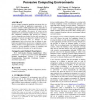Free Online Productivity Tools
i2Speak
i2Symbol
i2OCR
iTex2Img
iWeb2Print
iWeb2Shot
i2Type
iPdf2Split
iPdf2Merge
i2Bopomofo
i2Arabic
i2Style
i2Image
i2PDF
iLatex2Rtf
Sci2ools
MIDDLEWARE
2005
Springer
2005
Springer
Functional and architectural adaptation in pervasive computing environments
Service-oriented computing paradigm encourages the use of dynamic binding of application requirements to the resources needed to fulfill application tasks. Especially in pervasive computing that is characterized by disconnected operation and mobility, the process of using service specifications and dynamic binding becomes critical. For this, adaptation techniques that provide for seamless service composition are needed for user task execution. In this paper we present our approach to enable two kinds of adaptations: functional (due to changes in user requirements) and architectural (due to changes in nonfunctional requirements) in pervasive computing systems. The key features of our approach are to model services as workflows, service handoffs as points of variability, and context detailing for dynamic service provisioning. Categories and Subject Descriptors H.4.1 [Information Systems Applications]: Office Automation – workflow management; H.4.0 [Information Systems Applications] Ge...
| Added | 28 Jun 2010 |
| Updated | 28 Jun 2010 |
| Type | Conference |
| Year | 2005 |
| Where | MIDDLEWARE |
| Authors | Nanjangud C. Narendra, Umesh Bellur, S. K. Nandy, K. Kalapriya |
Comments (0)

